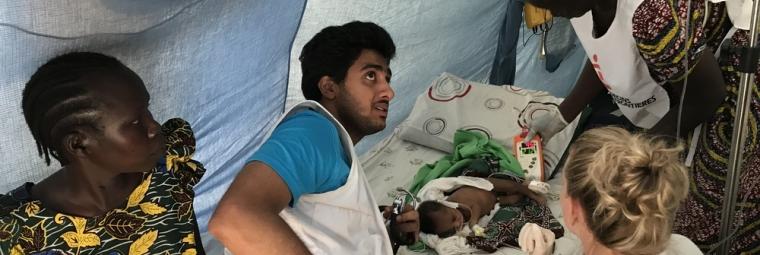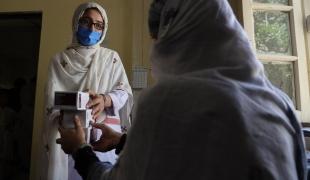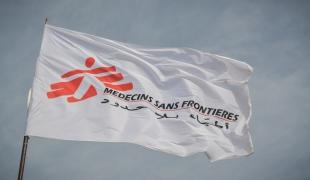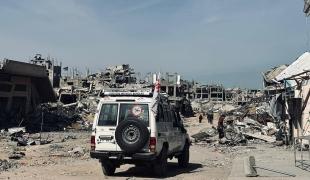Haiti: 24 hours with Alexandre, a doctor
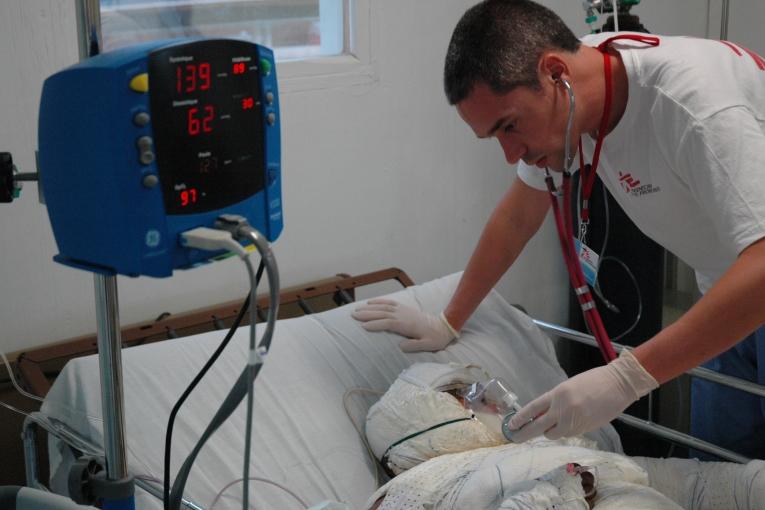
Alexandre is a hospital doctor. He is currently on his first mission as chief physician of the Burns Unit in the Drouillard Hospital in Port-au-Prince, which is located close to Cité Soleil in Haiti. He invited us to spend a day with him in the unit, which receives mostly child victims of accidents in the home.
06:45: The alarm sounds and I head for the shower. The water is so cold! It’s OK though, as it’s already very hot outside.
07:25: I arrive at the hospital. MSF has run all its operations out of the Drouillard Hospital in Port-au-Prince since 2011. Here, it’s a big hospital: more than 400 staff for over 100 beds.
Most of the patients are victims of serious accidents, like road accidents or accidental burns, but some also come in with knife or gunshot wounds. I work in the burns unit, which was restructured in 2013. We are the only specialist centre in Haiti.
07:30: I get to the unit and quickly check up on each section (intensive care, adults, children’s ward)
I go over the emergency cases with the teams and ask whether there have been any new admissions overnight
07:45: two children, one of which is a 3-month-old baby, arrived during the night. They have burns covering around 35% of their bodies.
A candle set a mosquito net in their room on fire. Half the population here still live with no electricity.
As they say here, “bourik chaje pa kanpe”! We’re going to be busy today.
08:00: intensive care. These are the most recent and most severe burn cases, where the condition of patients can change at any moment.
Pain, nutritional complications...everything must be checked and anticipated to help them through this difficult phase.
Two nurses and an auxiliary are always present here to care for patients and monitor the sick.
10:30: I head to the adults’ ward. This is where patients with major burns come who are through the initial phase of recovery and are starting to heal
There are also patients here with less serious burns who need to be hospitalised for a few days before receiving aftercare as an outpatient.
11:00: Burns often happen by accident: house fires, high-voltage lines that haven’t been maintained properly, gas explosions...
Dressings are changed every 2 days, either in the operating theatre under anaesthetic or in the ward.
12:00: Lastly, I get to the children’s ward. Most of the children here are between 1 and 2 years old, and have got burnt accidentally by hot food.
This type of burn heals quite quickly without needing any surgery, but can lead to skin contractures and impairments that can be quite serious. Led by Mickael – a Brazilian – the physio team works here all day to try and tackle this sort of problem.
13:30: the nurses remind me that “sak vid pa kanpe” (you can’t function on an empty stomach). I've finally seen all my 30 patients, so I snatch a quick lunch break.
13:35: on the menu is pikliz (a very spicy carrot and cabbage salad), pork griot, rice, bananas and fresh mango juice. Yum!
14:00: back to the hospital, and I stop by the lab to pick up the day’s blood test results. Then I head to the operating theatre to help with the day’s big dressings changes. I take the opportunity to pick up the wound photographs that were taken this morning.
We take photos of wounds at each dressing change for many patients so that we can monitor the healing process.
15:00: the medical division meets to discuss each patient.
We operate using advanced techniques, just as I would in my own country, so a high level of coordination within the team is required, as is staff training.
15:30: I also meet the surgeon to discuss patients who need to be scheduled in for excisional skin surgery/skin grafts. For major burns, this is the only way to ensure that wounds heal completely whilst also limiting functional and aesthetic sequelae.
16:30: after visiting patients, I schedule tomorrow’s operations with the nurse supervisor.
17:30: I return to see the patients in intensive care with the night team, change a few prescriptions and give out instructions.
18:30: I go back to the medical office and read through a few pages of the MSF guidelines on how to treat typhoid fever – it really is like my Bible when I’m away on a mission.
I finish the day with more admin-based tasks, like reading all my emails. Most of these are from the MSF Port-au-Prince medical coordination team and the Medical Department of the MSF head office in Paris.
19:30: back to MSF “base life” for a quick break. A few hammocks have been hung up in one corner, which is referred to as “Hammock Town” – I’ve asked why but no one seems to know
Around 20 people live here, from places like France, Brazil, the USA, DR Congo and Ivory Coast.
We all have very different roles: there are nurses, surgeons, doctors and logisticians, as well as people from Human Resources, financial management and so on.
20:00: this is when we all eat together – it’s relaxed and friendly.
22:30: I’m exhausted, so I’m going to bed early so that I’m in form tomorrow
One last Creole proverb for the road: “déyé mòn, gen mòn”. That means “behind one mountain, there’s always another”.
